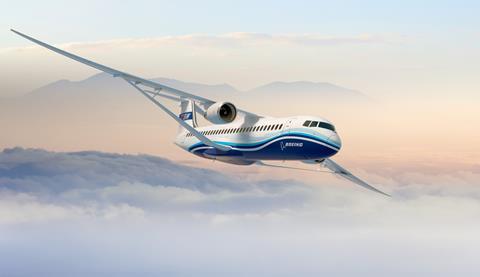NASA aims to launch a programme to advance technologies needed to support development of a “next-generation single-aisle” transport aircraft that is 25% more efficient than jets flying today.
Called the “Sustainable Flight National Partnership” (SFNP), the effort will include development of a “full-scale technology demonstrator X-plane, to test and validate integrated systems and their benefits”, according to recently released NASA budget documents.
The agency aims for the demonstrator to make first flight by fiscal year 2026.

NASA released the budget documents as President Joe Biden issued his 10-year budget proposal. Biden’s budget requests $24.8 billion for NASA in FY2022, up 6.6% from FY2021.
The SFNP broadly “aims to accomplish the aviation community’s aggressive climate change agenda and enhance America’s global leadership in aviation”, budget documents say.
“NASA Aeronautics’ cost-sharing partnerships with US industry will enable the next-generation single-aisle transport, expected by the early 2030s, to be a game-changing, ultra-efficient and low-carbon-emitting design at least 25% more fuel-efficient than today,” it adds.
Under the programme, NASA will “demonstrate the first-ever high-power hybrid-electric propulsion for large transport aircraft and ultra-high-efficiency long and slender wings”.
NASA intends to grant initial “electrified power train flight demonstration” contracts this year.
The effort includes evaluation of “advanced composite structures produced four-to-six times faster than current state-of-the-art advanced engine technologies”.
“NASA will ensure that technologies will be ready by the mid- to late-2020s to transition into US industry’s next generation of single-aisle transport aircraft,” it says.
NASA calls SFNP “a strong response to international challenges to US technology leadership for next-generation subsonic transports”.
Pressure has come from the European Union, which is supporting clean-propulsion development projects for aviation. The US aerospace industry also faces increasing competitive pressure from China.
News of NASA’s civil aviation work comes as the aviation industry awaits Boeing’s next move. Aerospace analysts suspect the company might launch a 737 replacement programme in the coming years, for service entry in the early 2030s.
Boeing has said its next project will rely heavily on technological improvement woven into its design, development and manufacturing processes.
Engine makers, meanwhile, continue to develop technologies such as hybrid-electric propulsion and hydrogen-powered systems, though such technologies are widely viewed as needing years of additional development.





























